Construction and Optimization of Green Infrastructure Network Based on Space Syntax: A Case Study of Suining County, Jiangsu Province
Abstract
:1. Introduction
Overview of the Study Area
2. Data Sources and Research Methods
2.1. Data Sources
2.2. Research Methods
2.3. Ecological Patch Identification and GI Network Construction
- n is the total number of patches in the core area screened by area;
- ai is the contribution of patch i (herein refers to the area);
- nlij is the number of connectivity between patches i and j;
- pij is the number of organisms in the two patches with the maximum probability of diffusion;
- I is the landscape connectivity value;
- IR is the landscape connectivity value after removing a patch.
2.4. GI Network Construction
2.5. Syntax and Correlation Analysis of Core GI Corridor Space
3. Result and Analysis
3.1. Plaque Functional Structure Composition Type
3.2. Plaque Spatial Structure Characteristics
3.3. Relevance Analysis Results
3.4. Optimization of the County GI Network
3.5. Ecological Source Expansion
3.6. Enhancement of Corridor Maintenance
3.7. Reinforcement of Stepping-Stones Construction
4. Findings and Discussion
4.1. Results Analysis
4.2. Research Prospect
Author Contributions
Funding
Institutional Review Board Statement
Informed Consent Statement
Data Availability Statement
Conflicts of Interest
References
- Landscape Institute. Green Infrastructure: Connected and Multi-Functional Landscapes; Landscape Institute: London, UK, 2010. [Google Scholar]
- Yao, X.; Zhang, D. The study of “tunnel effect” of ecological poverty reduction. J. Ecol. Environ. 2018, 27, 389–396. [Google Scholar]
- Xie, Y.; Fan, H.; Wang, Q.; Luo, Y.; Wang, X. Morphological spatial analysis and landscape composition of green infrastructure in major cities of Sichuan Province. Chin. Gard. 2019, 35, 107–111. [Google Scholar]
- Khan, S.A.R.; Ponce, P.; Thomas, G.; Yu, Z.; Al-Ahmadi, M.S.; Tanveer, M. Digital Technologies, Circular Economy Practices and Environmental Policies in the Era of COVID-19. Sustainability 2021, 13, 12790. [Google Scholar] [CrossRef]
- Khan, S.A.R.; Ponce, P.; Yu, Z. Technological innovation and environmental taxes toward a carbon-free economy: An empirical study in the context of COP-21. J. Environ. Manag. 2021, 298, 113418. [Google Scholar] [CrossRef] [PubMed]
- Tischendorf, L.; Fahrig, L. On the usage and measurement of landscape connectivity. OIKOS 2000, 90, 7–19. [Google Scholar] [CrossRef] [Green Version]
- Liu, Y.; Yang, L.; Jiang, W. Coupling coordination and spatiotemporal dynamic evolution between social economy and water environmental quality—A case study from Nansi Lake catchment, China. Ecol. Indic. 2020, 119, 106870. [Google Scholar] [CrossRef]
- Zhang, Z.; Li, Y.; Wang, X.; Xu, Y.; Liao, Y.; Wan, Z.; Tang, N. Investigating the spatiotemporal dynamic evolution and driving factors of wastewater treatment efficiency in the context of China’s River Chief system. Ecol. Indic. 2021, 129, 107991. [Google Scholar] [CrossRef]
- Pennino, M.J.; McDonald, R.I.; Jaffe, P.R. Watershed-scale impacts of stormwater green infrastructure on hydrology, nutrient fluxes, and combined sewer overflows in the mid-Atlantic region. Sci. Total Environ. 2016, 565, 1044–1053. [Google Scholar] [CrossRef] [Green Version]
- Demuzere, M.; Orru, K.; Heidrich, O.; Geneletti, D.; Orru, H.; Bhave, A.G.; Mittal, N.; Feliu, E.; Faehnle, M. Mitigating and adapting to climate change: Multi-functional and multi-scale assessment of green urban infrastructure. J. Environ. Manag. 2014, 146, 107–115. [Google Scholar] [CrossRef]
- Skokanová, H.; Netopil, P.; Havlíček, M.; Šarapatka, B. The role of traditional agricultural landscape structures in changes to green infrastructure connectivity. Agric. Ecosyst. Environ. 2020, 302, 107071. [Google Scholar] [CrossRef]
- Szulczewska, B.; Giedych, R.; Maksymiuk, G. Can we face the challenge: How to implement a theoretical concept of green infrastructure into planning practice? Warsaw case study. Landsc. Res. 2016, 42, 176–194. [Google Scholar] [CrossRef]
- Jordán, F.; Báldi, A.; Orci, K.-M.; Rácz, I.; Varga, Z. Characterizing the importance of habitat patches and corridors in maintaining the landscape connectivity of a Pholidoptera transsylvanica (Orthoptera) metapopulation. Landsc. Ecol. 2003, 18, 83–92. [Google Scholar] [CrossRef]
- Li, K.; Li, C.; Cao, J.; One, P.; Liu, M.; Lu, J.; Hao, Z. Spatial-temporal pattern evolution of green infrastructure in central Liaoning urban agglomeration in 20 years based on landscape ecology. J. Ecol. 2021, 41, 8408–8420. [Google Scholar]
- Lin, H.; Qian, J.; Yan, L.; Huang, S. Spatial-temporal pattern change and scenario simulation of green in-frastructure in Wuyi County based on morphological spatial pattern analysis and CA-Markov model. J. Zhejiang Agric. 2019, 31, 1193–1204. [Google Scholar]
- Pascual-Hortal, L.; Saura, S. Comparison and development of new graph-based landscape connectivity indices: Towards the priorization of habitat patches and corridors for conservation. Landsc. Ecol. 2006, 21, 959–967. [Google Scholar] [CrossRef]
- Qiu, B.; Qi, W.; Chen, C.; Li, W. Relationship between spatial heterogeneity and wavelength in multisensor airborne images. Geo-Spat. Inf. Sci. 2015, 18, 56–64. [Google Scholar] [CrossRef] [Green Version]
- Calderón-Contreras, R.; Quiroz-Rosas, L.E. Analysing scale, quality and diversity of green infrastructure and the provision of Urban Ecosystem Services: A case from Mexico City. Ecosyst. Serv. 2017, 23, 127–137. [Google Scholar] [CrossRef]
- Fňukalová, E.; Zýka, V.; Romportl, D. The Network of Green Infrastructure Based on Ecosystem Services Supply in Central Europe. Land 2021, 10, 592. [Google Scholar] [CrossRef]
- He, K.; Yu, K.; Gao, Y.; Liu, J. Construction of Fuzhou green infrastructure network based on MSPA. Chin. Gard. 2019, 35, 70–75. [Google Scholar]
- Hu, T.; Chang, J.; Syrbe, R.-U. Green Infrastructure Planning in Germany: The Background, Spatial Framework and Implementations. Int. Urban Plan. 2021, 36, 109–119. [Google Scholar]
- Li, Y. Theory and practice of ecological restoration of urban rivers from the perspective of green infrastructure—A case study of Seattle. Urban Plan. Int. 2018, 33, 41–47. [Google Scholar] [CrossRef]
- Suškevičs, M. Legitimate planning processes or informed decisions? Exploring public officials’ rationales for participation in regional green infrastructure planning in Estonia. Environ. Policy Gov. 2019, 29, 132–143. [Google Scholar] [CrossRef]
- Rosot, M.A.D.; Maran, J.C.; da Luz, N.B.; Garrastazú, M.C.; de Oliveira, Y.M.M.; Franciscon, L.; Clerici, N.; Vogt, P.; de Freitas, J.V. Riparian forest corridors: A prioritization analysis to the Landscape Sample Units of the Brazilian National Forest Inventory. Ecol. Indic. 2018, 93, 501–511. [Google Scholar] [CrossRef]
- Shi, X.; Qin, M. Research on the Optimization of Regional Green Infrastructure Network. Sustainability 2018, 10, 4649. [Google Scholar] [CrossRef] [Green Version]
- Hillier, B. Space is the Machine: A Configurational Theory of Architecture; Cambridge University Press: Cambridge, UK, 1999. [Google Scholar]
- Yu, Y.; Yin, H.; Kong, F.; Wang, J.; Xu, W. Spatial and temporal change analysis of Nanjing green infrastructure network pattern based on MSPA. J. Ecol. 2016, 35, 1608–1616. [Google Scholar]
- Wu, Y.; Wang, Q.; Luo, Y. Research on the characteristics of Chengdu green infrastructure network structure based on MSPA. J. Northwest For. Univ. 2017, 32, 260–265. [Google Scholar]
- Mell, I.C.; Henneberry, J.; Hehl-Lange, S.; Keskin, B. To green or not to green: Establishing the economic value of green infrastructure investments in The Wicker, Sheffield. Urban For. Urban Green. 2016, 18, 257–267. [Google Scholar] [CrossRef]
- Zhang, J.; Zhu, H.; Zhang, P.; Song, Y.; Zhang, Y.; Li, Y.; Rong, T.; Liu, Z.; Yang, D.; Lou, Y. Construction and optimization of Jiangsu Province ecological network based on MSPA and MCR models. Ecol. Sci. 2019, 38, 138–145. [Google Scholar]
- Bowman, J.T. Connecting National Wildlife Refuges with Green Infrastructure: The Sherburne Crane Meadows Complex; University of Minnesota: St. Paul, MN, USA, 2008. [Google Scholar]
- Wei, J.; Yi, S.; Wang, Y.; Xiang, W. Construction of green infrastructure network in rapidly urbanizing areas based on spatial priority—Taking Pukou District of Nanjing as an example. J. Ecol. 2019, 39, 1178–1188. [Google Scholar]
- Wu, Z.; Tian, F. The analysis of urban recreational space morphology based on space syntax—Taking the main urban area of Nanchang as an example. Econ. Geogr. 2012, 32, 156–161. [Google Scholar]
- Zhu, Q.; Yu, K.; Li, D. The width of ecological corridor in landscape planning. Acta Ecol. Sin. 2005, 25, 2406–2412. [Google Scholar]
- Wang, Y.; Li, J.; Gu, K.; Lin, L. Optimization of urban green infrastructure network layout based on MSPA-CIRCUIT: Case of Hefei. J. Ecol. 2022, 42, 2022–2032. [Google Scholar]
- Huang, N.; Shi, T.; Shi, Y.; Li, C.; Hu, Y. Research progress on ecological and social function of green infrastructure. Acta Ecol. Sin. 2021, 41, 7946–7954. [Google Scholar] [CrossRef]
- Song, Q.; Feng, W. Green infrastructure construction drives urban renewal. Mod. Urban Stud. 2021, 10, 58–62. [Google Scholar]
- Karanikola, P.; Panagopoulos, T.; Tampakis, S.; Karipidou-Kanari, A. A perceptual study of users’ expectations of urban green infrastructure in Kalamaria, municipality of Greece. Manag. Environ. Qual. Int. J. 2016, 27, 568–584. [Google Scholar] [CrossRef]
- Liu, W.; Holst, J.; Yu, Z. Thresholds of landscape change: A new tool to manage green infrastructure and social–economic development. Landsc. Ecol. 2014, 29, 729–743. [Google Scholar] [CrossRef]
- Weber, T.; Sloan, A.; Wolf, J. Maryland’s Green Infrastructure Assessment: Development of a comprehensive approach to land conservation. Landsc. Urban Plan. 2006, 77, 94–110. [Google Scholar] [CrossRef]
- Zhou, Q.; Shi, W.; Guo, Q. Influence mechanism of urban environment and green infrastructure construction on high-quality development of urban economy. J. Ecol. 2021, 41, 8820–8832. [Google Scholar]
- Liu, W.; Zhou, Z.; Lang, R. The relationship between supply and demand of urban green infrastructure ecosystem services and spatial optimization-taking Xi’an as an example. Arid. Area Geogr. 2021, 44, 1500–1513. [Google Scholar]
- Khan, S.A.R.; Godil, D.I.; Jabbour, C.J.C.; Shujaat, S.; Razzaq, A.; Yu, Z. Green data analytics, blockchain technology for sustainable development, and sustainable supply chain practices: Evidence from small and medium enterprises. Ann. Oper. Res. 2021, 10, 1–25. [Google Scholar] [CrossRef]
- Khan, S.A.R.; Godil, D.I.; Yu, Z.; Abbas, F.; Shamim, M.A. Adoption of renewable energy sources, low-carbon initiatives, and advanced logistical infrastructure—A step toward integrated global progress. Sustain. Dev. 2021, 30, 275–288. [Google Scholar] [CrossRef]
- Zhang, Z.; Liu, Y.; Li, Y.; Wang, X.; Li, H.; Yang, H.; Ding, W.; Liao, Y.; Tang, N.; He, F. Lake ecosystem health assessment using a novel hybrid decision-making framework in the Nam Co, Qinghai-Tibet Plateau. Sci. Total Environ. 2021, 808, 152087. [Google Scholar] [CrossRef] [PubMed]
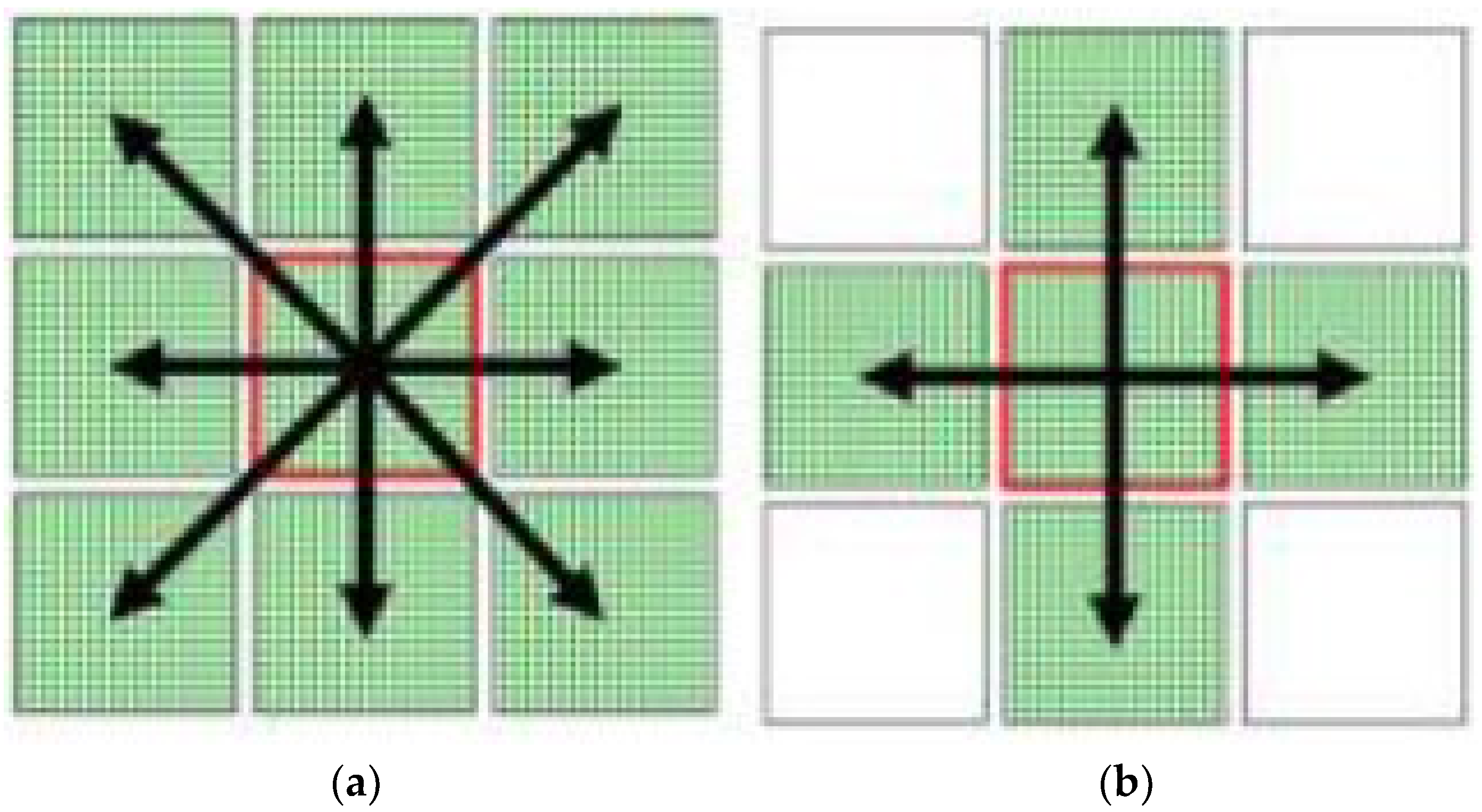

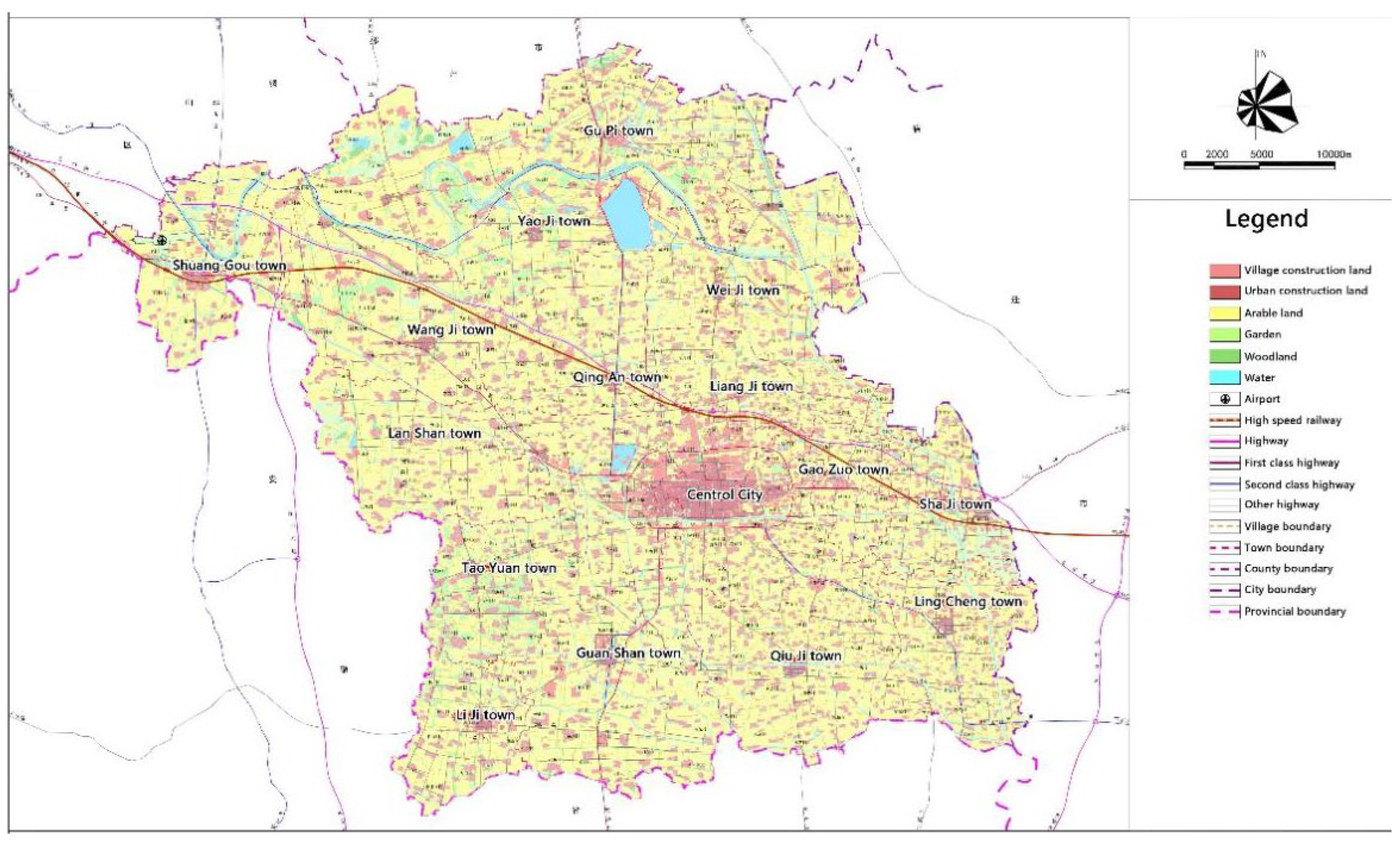



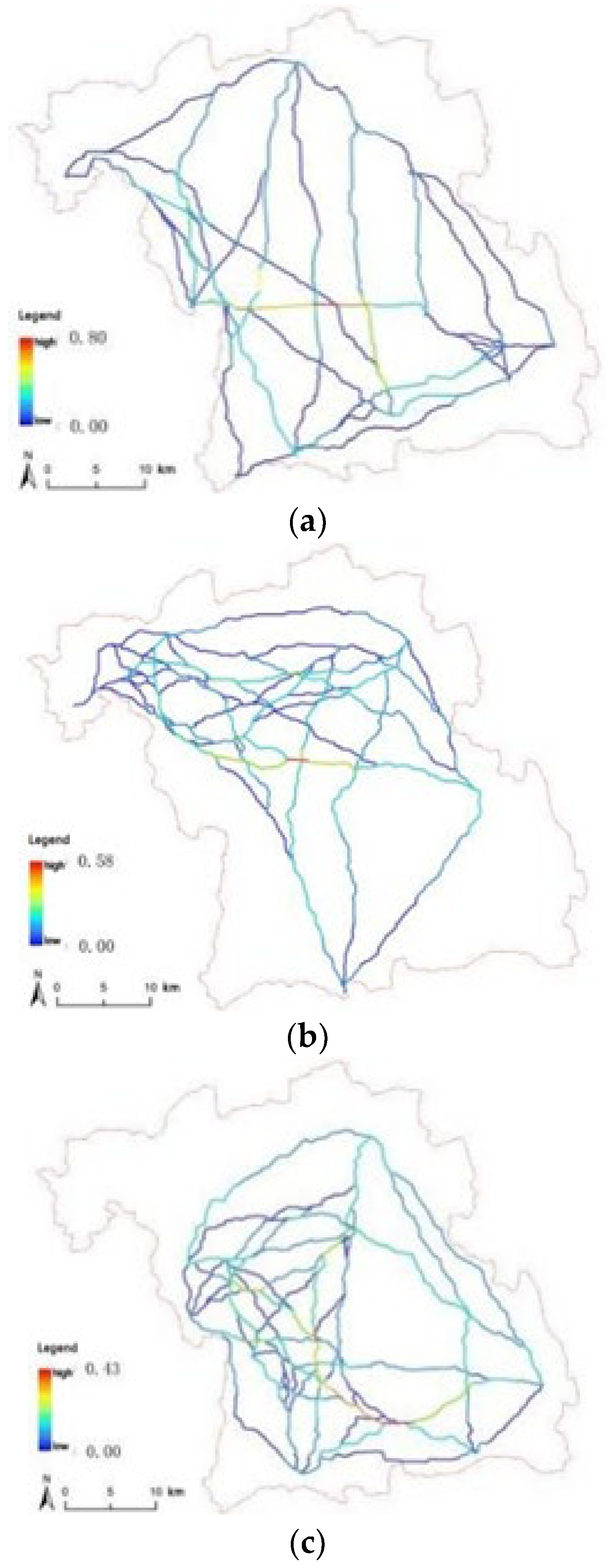
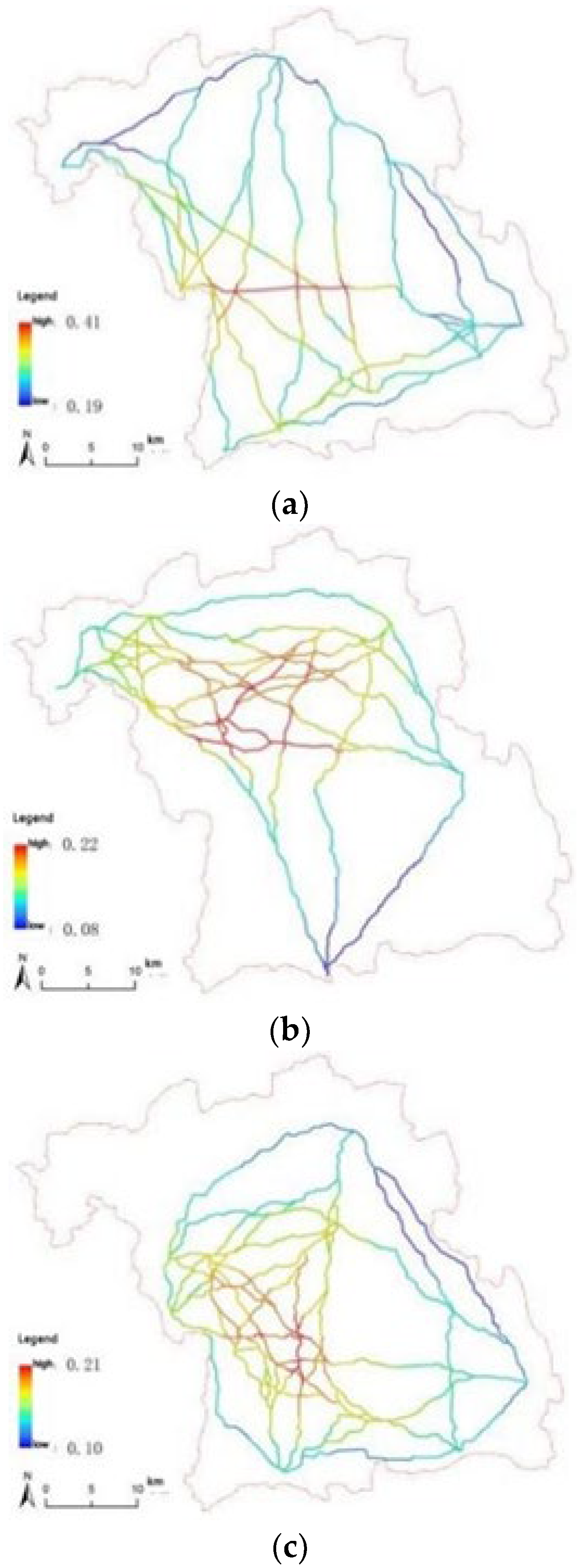
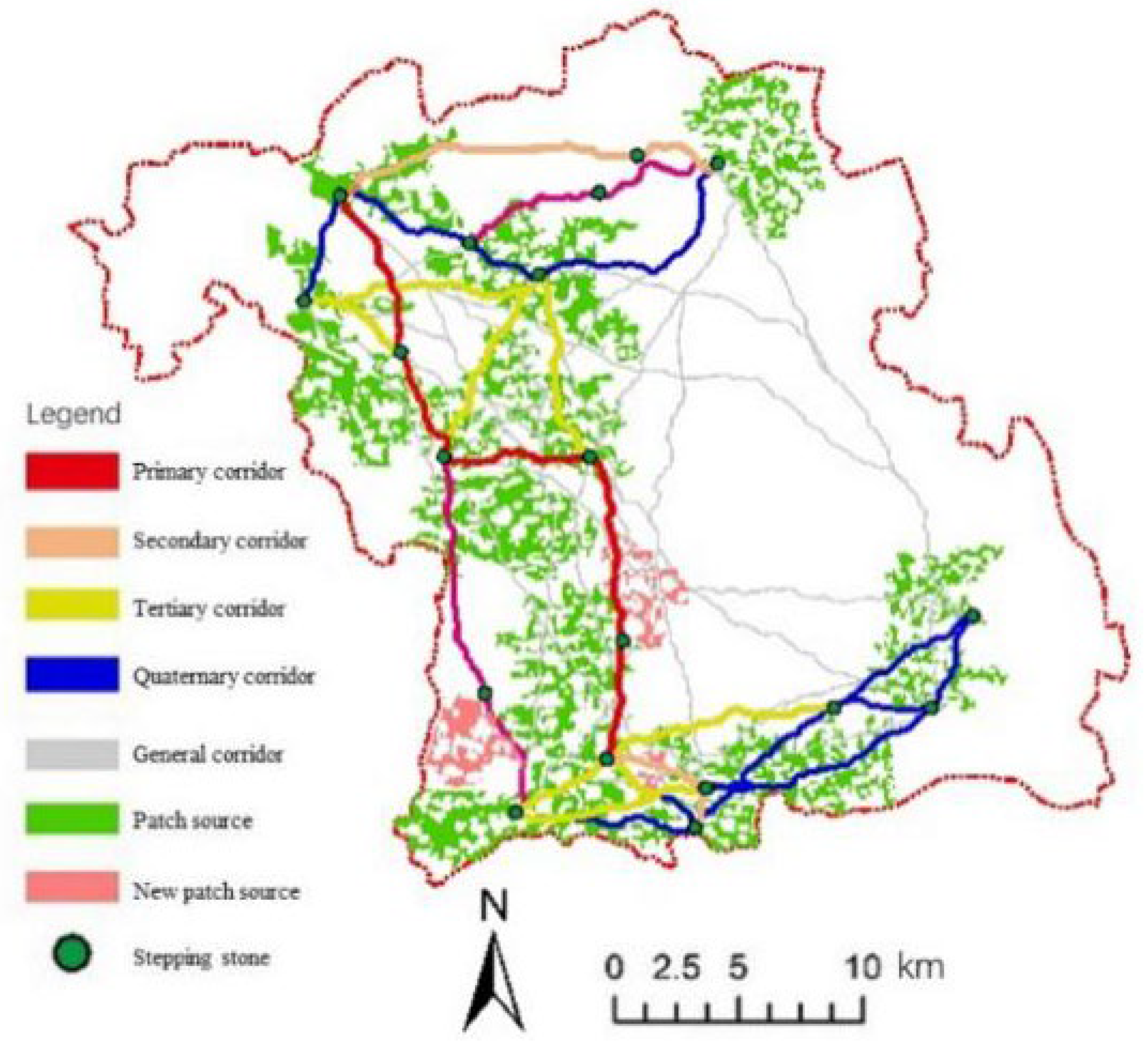

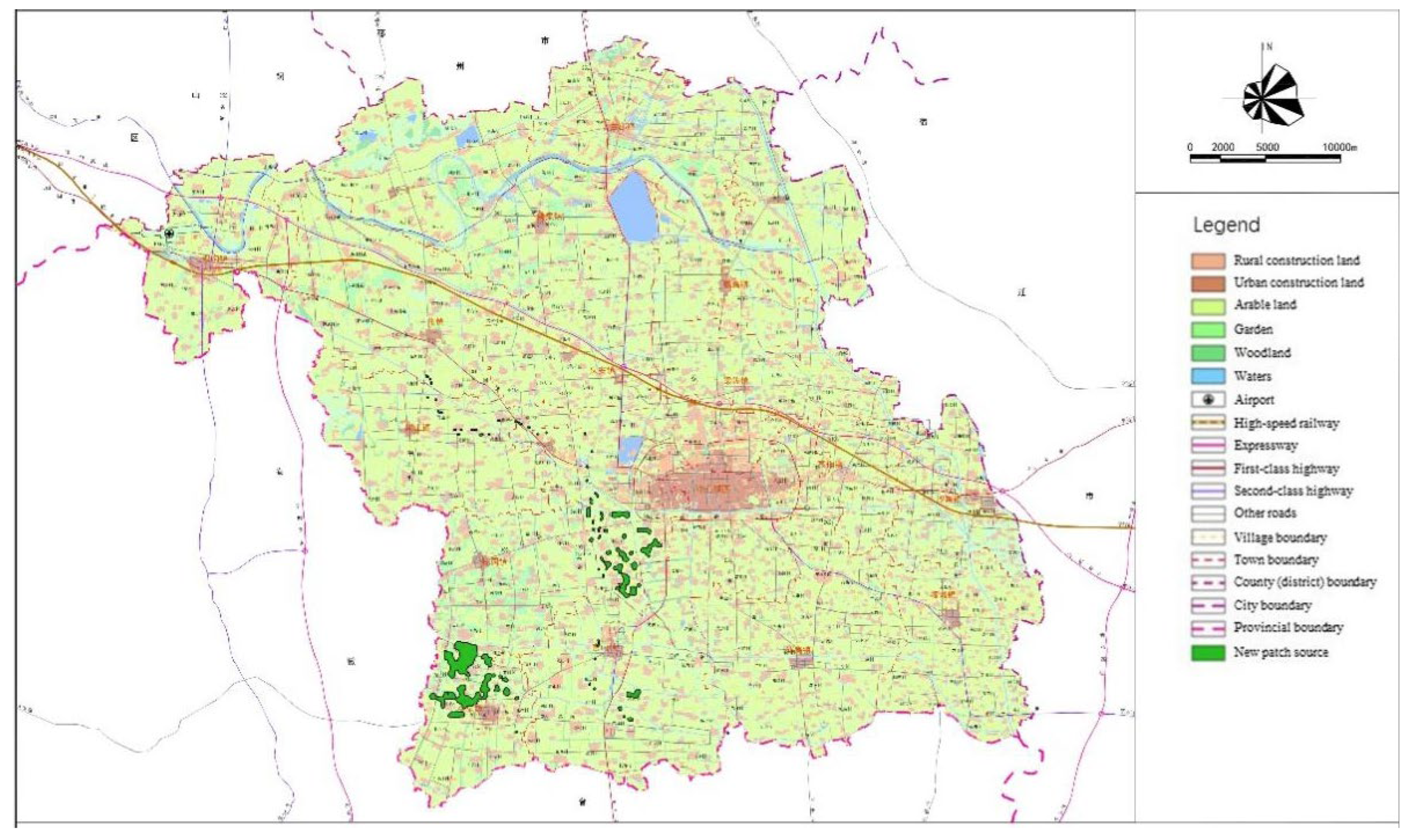
| Method | Content | |
|---|---|---|
| Barbara et al. [12] | Conduct GI resistance model analysis | Spatial analysis of GI in different areas |
| F. Jordán et al. [13] | Adopt an approach for building ecological corridor connectivity | |
| Li Kongming et al. [14] | Conduct MSPA | |
| Lin Hongyu et al. [15] | ||
| Lucía Pascual-Hortal et al. [16] | Build a new index | |
| Bingwen Qiu et al. [17] | Apply variogram modeling | Investigation of the relation between spatial heterogeneity and spectral wavelength for objects |
| Demuzere M et al. [10] | Carry out statistical analysis | Significance of GI |
| Rafael Calderón-Contreras et al. [18] | Utilize remote sensing technology and the normalized difference vegetation index (NDVI) combined with fieldwork verification | |
| Fňukalová Eliška et al. [19] | Conduct analysis of ecological corridor maintenance capacity | Identification of GI networks in different areas |
| Huang He et al. [20] | Analyze GI pattern based on the MSPA method | |
| Hu Tinghao et al. [21] | Use literature analysis and case analysis methods | An overview of the concept of GI |
| Liya [22] | Conduct case analysis | |
| Hana Skokanová et al. [23] | Conduct MSPA and equivalent connected area (ECA) calculation | Spatial variation characteristics of GI in different historical periods |
| Michael J et al. [24] | Quantify the role of Stormwater GI | Quantification of the cumulative effects of multiple SGI projects |
| Monika Suškevičs et al. [25] | Conduct case analysis | Role of public participation in the advancement of GI projects |
| Resistance Layers | Weight Allocation | Impact Factors | Resistance |
|---|---|---|---|
| MSPA elements | 0.35 | Core | 5 |
| Bridge | 10 | ||
| Islet | 20 | ||
| Loop | 30 | ||
| Branch | 40 | ||
| Perforation | 60 | ||
| Edge | 70 | ||
| Background | 100 | ||
| Land use types | 0.25 | Woodland | 10 |
| Arable land | 30 | ||
| Bare land | 40 | ||
| Waters | 70 | ||
| Construction land | 100 | ||
| Elevation | 0.17 | h ≤ 0 m | 5 |
| 0 m ≤ h ≤ 20 m | 15 | ||
| 20 m ≤ h ≤ 40m | 30 | ||
| 40 m ≤ h ≤ 200 m | 45 | ||
| 200 m < h | 100 | ||
| Slope | 0.23 | i ≤ 8° | 1 |
| 8°≤ i ≤ 15° | 20 | ||
| 15°≤ i ≤ 25° | 60 | ||
| 25 ≤ i ≤ 35° | 80 | ||
| 35° ≤ i | 100 |
| Choice | Integration [HH] | Mean Depth | Area | dIIC | dPC | ||
|---|---|---|---|---|---|---|---|
| Choice | Pearson correlation | 1 | −0.706 ** | 0.985 ** | −0.141 | −0.151 | −0.157 |
| Sig. (Double tail) | 0.003 | 0.000 | 0.617 | 0.591 | 0.576 | ||
| Number of cases | 15 | 15 | 15 | 15 | 15 | 15 | |
| Integration [HH] | Pearson correlation | −0.706 ** | 1 | −0.710 ** | −0.015 | 0.008 | 0.009 |
| Sig. (Double tail) | 0.003 | 0.003 | 0.957 | 0.977 | 0.975 | ||
| Number of cases | 15 | 15 | 15 | 15 | 15 | 15 | |
| Mean Depth | Pearson correlation | 0.985 ** | −0.710 ** | 1 | −0.129 | −0.135 | −0.138 |
| Sig. (Double tail) | 0.000 | 0.003 | 0.646 | 0.632 | 0.623 | ||
| Number of cases | 15 | 15 | 15 | 15 | 15 | 15 | |
| Area | Pearson correlation | −0.141 | −0.015 | −0.129 | 1 | 0.997 ** | 0.989 ** |
| Sig. (Double tail) | 0.617 | 0.957 | 0.646 | 0.000 | 0.000 | ||
| Number of cases | 15 | 15 | 15 | 15 | 15 | 15 | |
| dIIC | Pearson correlation | −0.151 | 0.008 | −0.135 | 0.997 ** | 1 | 0.997 ** |
| Sig. (Double tail) | 0.591 | 0.977 | 0.632 | 0.000 | 0.000 | ||
| Number of cases | 15 | 15 | 15 | 15 | 15 | 15 | |
| dPC | Pearson correlation | −0.157 | 0.009 | −0.138 | 0.989 ** | 0.997 ** | 1 |
| Sig. (Double tail) | 0.576 | 0.975 | 0.623 | 0.000 | 0.000 | ||
| Number of cases | 15 | 15 | 15 | 15 | 15 | 15 | |
| Normalized Choice | Maximum Value | Minimum Value | Average Value |
|---|---|---|---|
| 1998 | 1998 | 0.8036 | 0.0013 |
| 2008 | 2008 | 0.5817 | 0.0011 |
| 2018 | 2018 | 0.4333 | 0.0014 |
| Global Integration | Maximum Value | Minimum Value | Average Value |
|---|---|---|---|
| 1998 | 0.4118 | 0.1902 | 0.2774 |
| 2008 | 0.2235 | 0.0832 | 0.1647 |
| 2018 | 0.2053 | 0.0978 | 0.1543 |
Publisher’s Note: MDPI stays neutral with regard to jurisdictional claims in published maps and institutional affiliations. |
© 2022 by the authors. Licensee MDPI, Basel, Switzerland. This article is an open access article distributed under the terms and conditions of the Creative Commons Attribution (CC BY) license (https://creativecommons.org/licenses/by/4.0/).
Share and Cite
Wang, F.; Chen, J.; Tong, S.; Zheng, X.; Ji, X. Construction and Optimization of Green Infrastructure Network Based on Space Syntax: A Case Study of Suining County, Jiangsu Province. Sustainability 2022, 14, 7732. https://doi.org/10.3390/su14137732
Wang F, Chen J, Tong S, Zheng X, Ji X. Construction and Optimization of Green Infrastructure Network Based on Space Syntax: A Case Study of Suining County, Jiangsu Province. Sustainability. 2022; 14(13):7732. https://doi.org/10.3390/su14137732
Chicago/Turabian StyleWang, Feng, Jiongzhen Chen, Shuai Tong, Xin Zheng, and Xiang Ji. 2022. "Construction and Optimization of Green Infrastructure Network Based on Space Syntax: A Case Study of Suining County, Jiangsu Province" Sustainability 14, no. 13: 7732. https://doi.org/10.3390/su14137732






